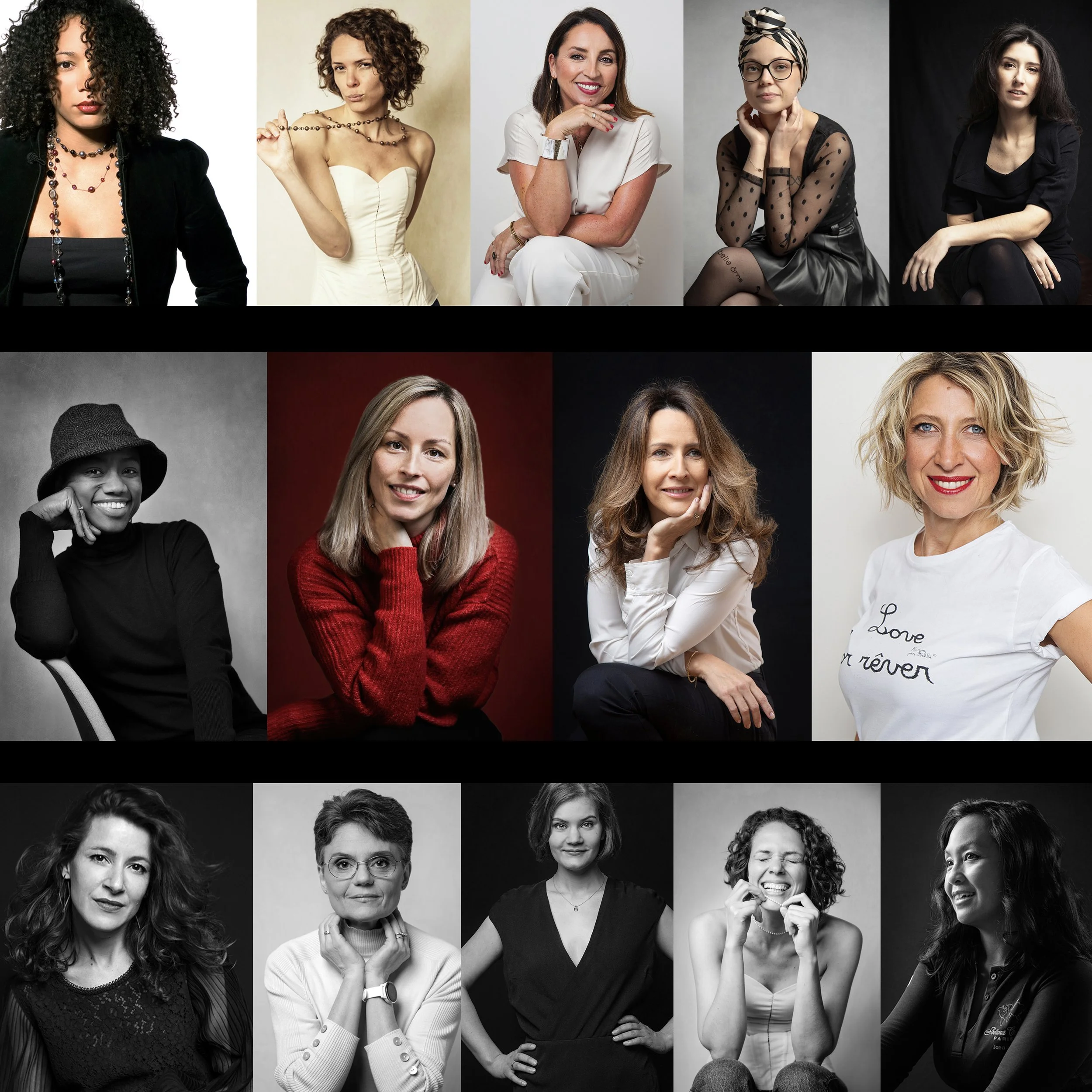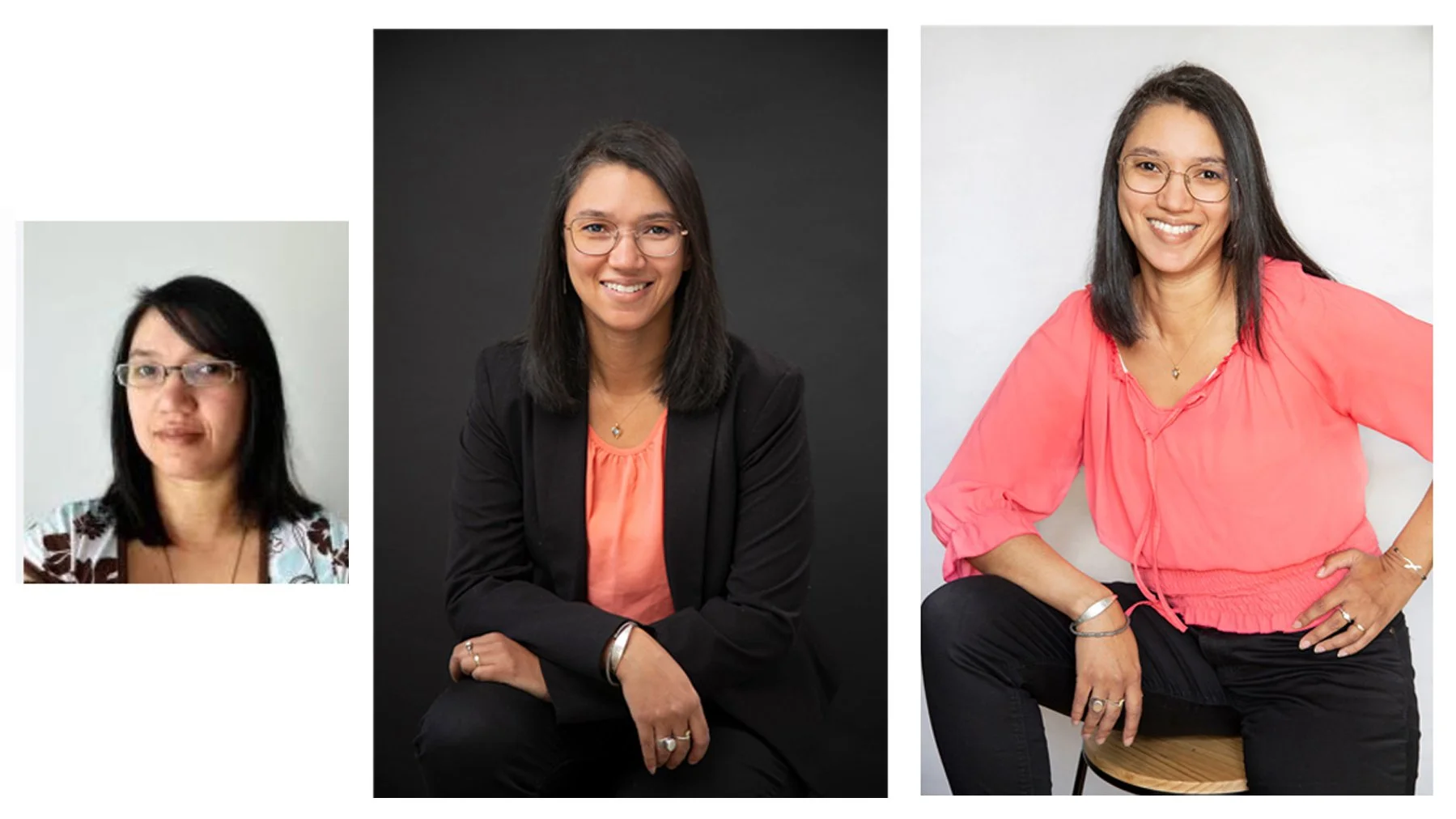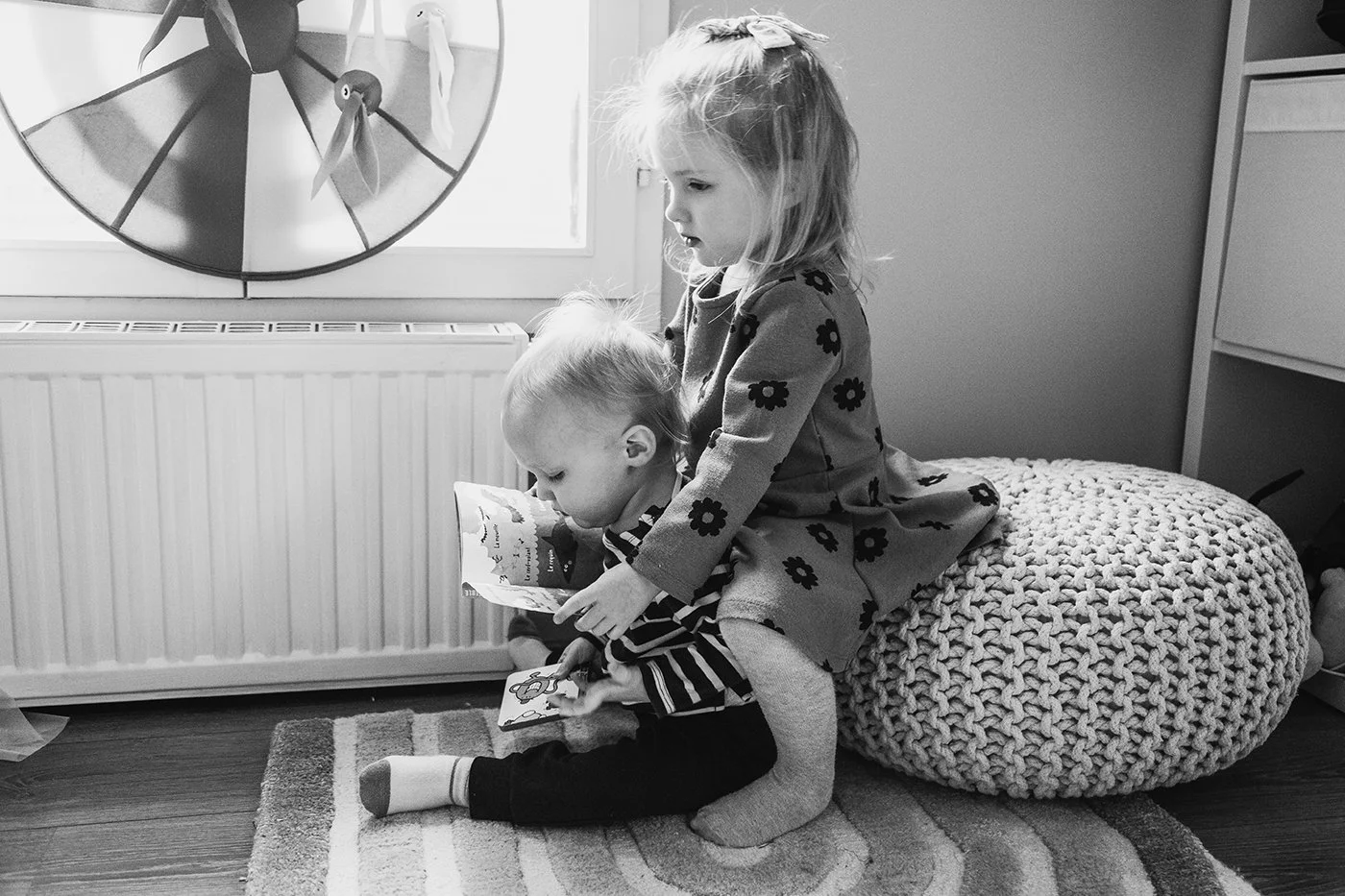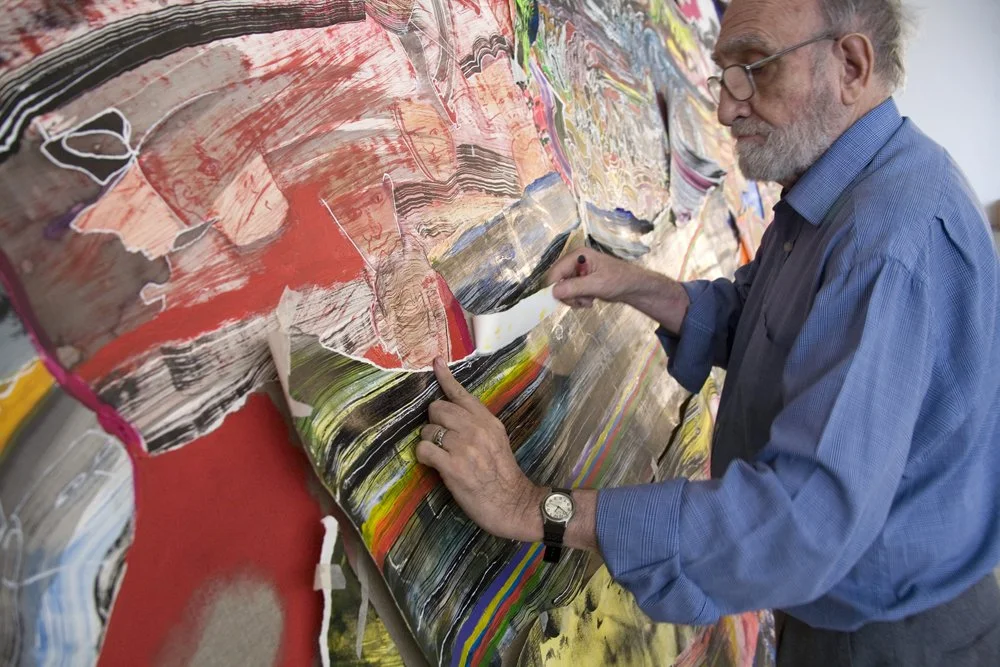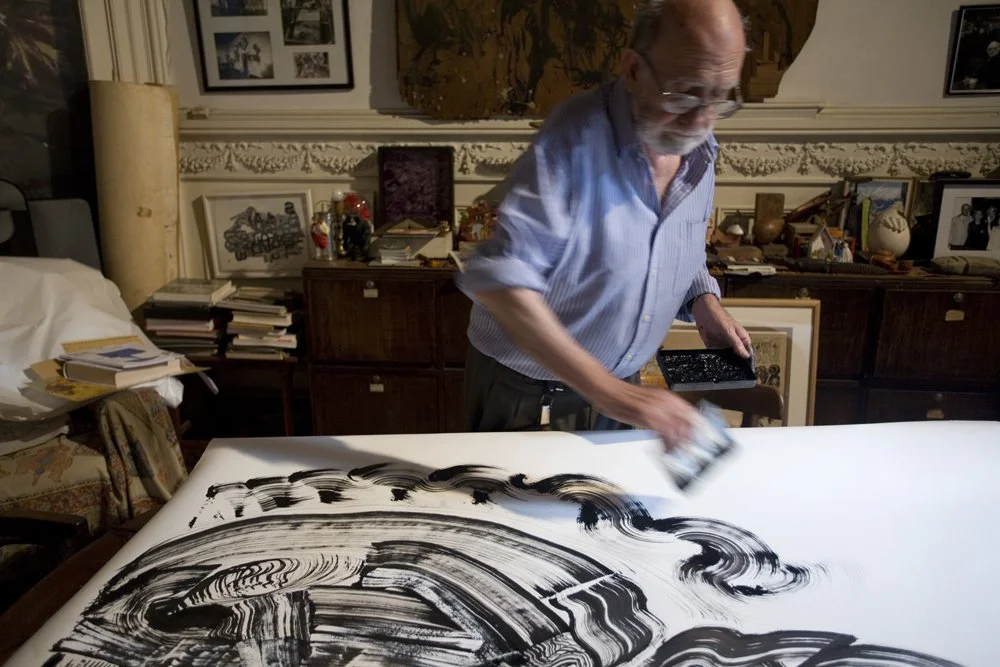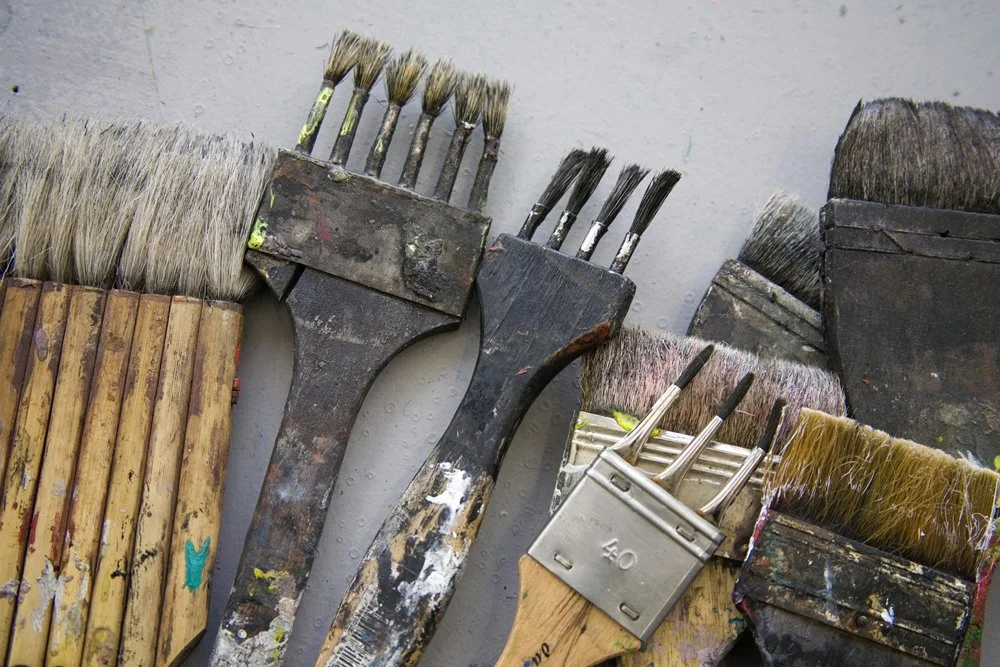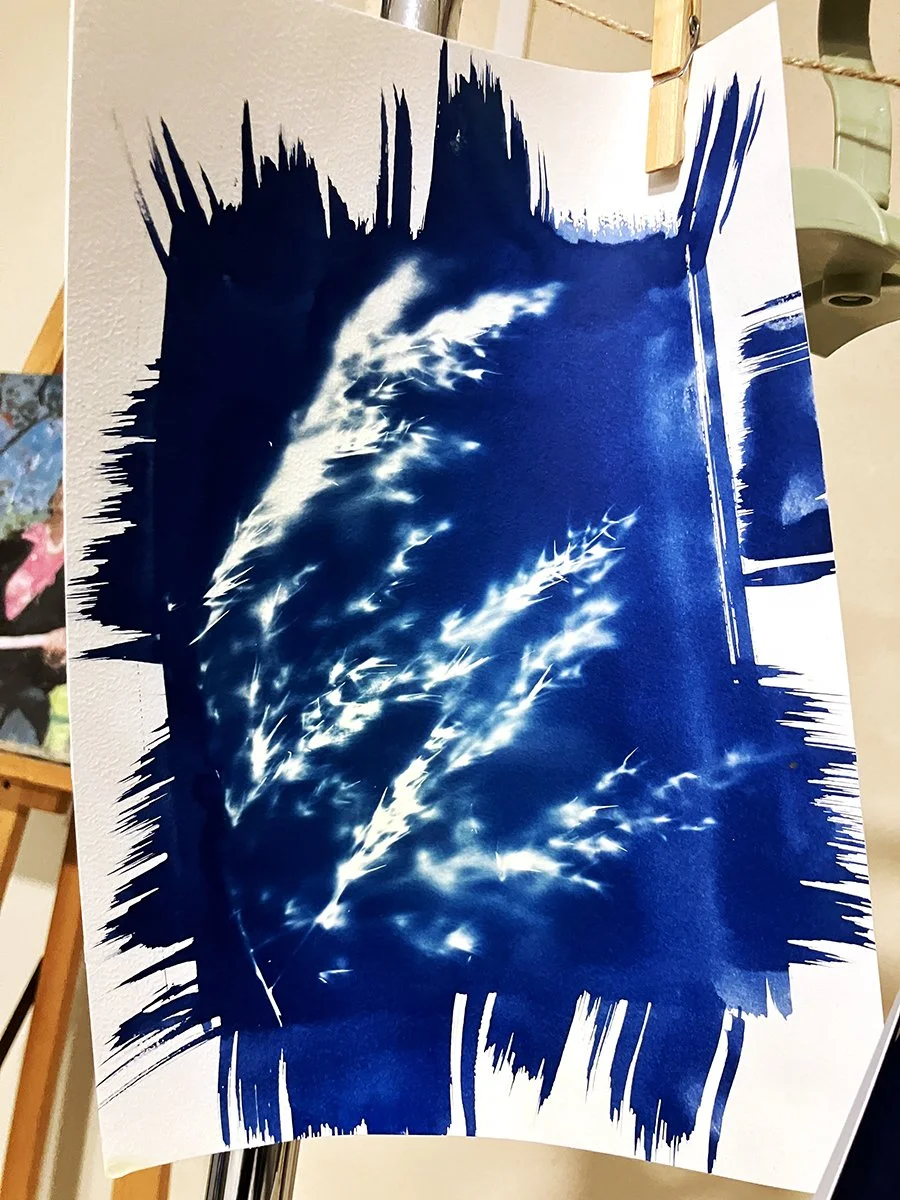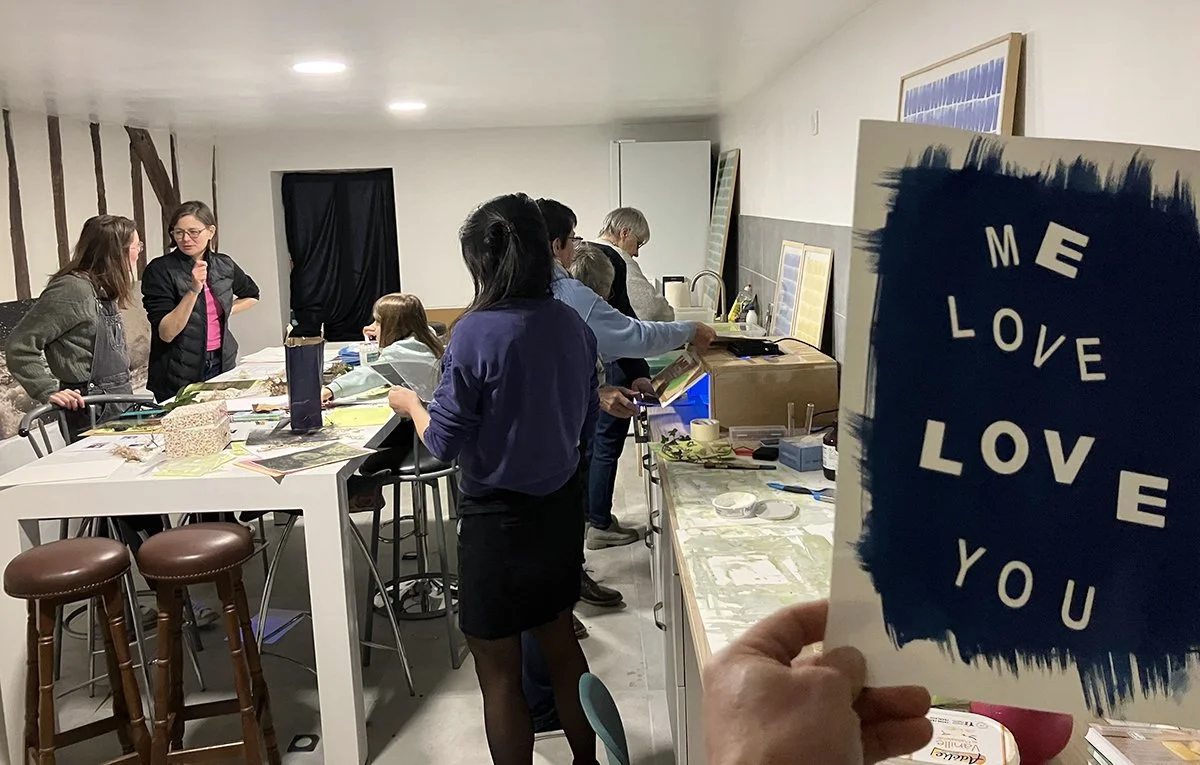
Dani’s Blog
Professional Headshots for LinkedIn & Business
Version français ci-dessous
It’s not really about the photograph
Getting professional portraits taken can feel intimidating for a lot of people.
You book a session because you need good photos for your website, LinkedIn profile, promo materials, etc. Maybe it feels scary, sounds boring, and you wonder if that selfie you took with your phone is “good enough.” Or you’ve even thought about letting AI generate a headshot for you instead.
The truth is: it’s not really about the photo. It’s about you.
A selfie or a photo of yourself relaxed, on vacation, could work for a while, but when you’re building your career, growing your business, and wanting to really connect with clients in a virtual space, there’s a big difference. Everyone is showing up with a polished business portrait that communicates professionalism, trust, and personality. The “know-like-trust” factor increases when your photo is real, sincere, and we can feel a bit of who you really are. AI images might be eye-catching, but they’re just not you.
That’s the thing that hits home to me, in this AI conversation. If we decide to present avatars, or fake images of ourselves, then we’re stepping even farther away from real connection, going into a more virtual, out-of-body reality than we’re already in. Personally, that’s the opposite direction I want to go in.
When you sit, stand, pose, laugh, and have a real conversation with a photographer, the pictures are created from a relationship. It can’t be otherwise. The photographer can’t take themselves out of the picture, because we’re all reflecting off of each other. That’s why it’s so important to choose the RIGHT photographer, someone you feel comfortable with and trust with this important job of capturing you in 1/125th of a second.
The photo she was using before and after our portrait session
That difference came through so clearly in a session I did recently with Sandrine.
One of the first things she told me was that she doesn’t smile much in photos, it’s just not something that came spontaneously. But during her portrait session, with my guidance something shifted. Together, we created a series of images with genuine, radiant smiles that came naturally, not forced.
When I turned the camera around to show her, she was amazed. She said, “I’ve never seen myself like that.”
The photos lit her up with confidence. And I know they’re going to be pivotal for her as she continues on her path. I’m delighted to be part of her evolution.
That’s the power of a professional headshot. It’s not just a picture; it’s a reflection and a witness of who you are in this moment of your life. You live that moment, AI cannot create that.
When you see yourself looking confident, approachable, and authentic, it changes the way you show up in the world. And when your clients, colleagues, or future employers see that, they feel it too.
A good portrait brings out the best of you. It’s a tool you can use everywhere: on your website, in your email signature, on LinkedIn, and other marketing materials.
Check out more of my professional photos and think about how we might be able to uplevel your current portraits. It’s always a fun time.
If you’d like to get on my email list to know when I offer deals and other good stuff, click here.
Ce n’est pas vraiment une question de photo
Se faire photographier par un professionnel peut être intimidant pour beaucoup de gens.
On réserve une séance parce qu’on a besoin de belles images pour son site web, son profil LinkedIn, ses supports de communication, etc. Peut-être que ça fait un peu peur, ou que ça semble ennuyeux, et on se demande si le selfie qu’on a pris avec son téléphone n’est pas “suffisant”. Ou alors, on a même pensé laisser l’IA générer un portrait à notre place.
La vérité, c’est que ce n’est pas vraiment une question de photo.
C’est une question de vous.
Un selfie ou une photo prise en vacances, détendu, peut fonctionner un temps, mais quand on construit sa carrière, qu’on fait grandir son activité et qu’on cherche à créer un vrai lien avec ses clients dans un espace virtuel, la différence est immense.
Tout le monde se présente aujourd’hui avec un portrait professionnel soigné, qui communique la confiance, le sérieux et la personnalité. Le fameux facteur “know-like-trust” grandit quand votre image est réelle, sincère, et qu’on peut sentir un peu de qui vous êtes vraiment. Les images générées par IA peuvent être frappantes, mais elles ne sont pas vous.
C’est ce qui me touche profondément dans cette discussion autour de l’IA. Si on choisit de se présenter sous forme d’avatars ou d’images fausses, on s’éloigne encore un peu plus de la vraie connexion humaine, pour aller vers une réalité plus virtuelle, plus désincarnée, que celle dans laquelle on vit déjà. Personnellement, c’est la direction opposée à celle que je veux prendre.
Quand on s’assoit, qu’on bouge, qu’on rit et qu’on a une vraie conversation avec un photographe, les images naissent d’une relation. Il ne peut pas en être autrement. Le photographe ne peut pas s’effacer de la photo, parce qu’on se reflète mutuellement.
C’est pour ça qu’il est essentiel de choisir le bon photographe, celui avec qui on se sent à l’aise, en confiance, et à qui on peut confier cette mission importante : capturer votre essence en 1/125e de seconde.
Cette différence s’est manifestée très clairement lors d’une séance que j’ai récemment faite avec Sandrine.
L’une des premières choses qu’elle m’a dites, c’est qu’elle ne sourit pas trop sur les photos, que ça ne venait pas naturellement. Mais pendant sa séance, quelque chose a changé. Avec mes indications, un espace s’est ouvert, et ensemble, nous avons créé une série d’images avec de vrais sourires, rayonnants, spontanés, pas forcés.
Quand je lui ai montré les photos sur l’écran, elle a été stupéfaite. Elle m’a dit : “Je ne me suis jamais vue comme ça.”
Les photos l’ont illuminée, lui ont donné confiance. Et je sais qu’elles vont jouer un rôle clé dans la suite de son parcours. Je suis ravie d’avoir pu participer à cette évolution.
C’est ça, le pouvoir d’un portrait professionnel. Ce n’est pas juste une image ; c’est un miroir, un témoin de qui vous êtes à ce moment précis de votre vie. Vous vivez ce moment. L’IA, elle, ne peut pas le créer.
Quand vous vous voyez confiant·e, accessible et authentique, ça change la manière dont vous vous présentez au monde. Et quand vos clients, collègues ou futurs employeurs voient cette image, ils le ressentent aussi.
Un bon portrait révèle le meilleur de vous-même. C’est un outil que vous pouvez utiliser partout : sur votre site web, dans votre signature d’email, sur LinkedIn, et dans tous vos supports de communication.
Découvrez d’autres portraits professionnels que j’ai réalisés et réfléchissons ensemble à comment donner un nouveau souffle à vos images actuelles. C’est toujours fun, promis.
Et si vous souhaitez rejoindre ma liste d’envoi pour être informé·e de mes offres et autres nouveautés, cliquez ici.
The Best Places for Family Photo Shoots in the Fontainebleau Area
Version français ci-dessous
Simple, beautiful locations where families can relax.
Choosing the right spot for your family photos is so fun. We’re lucky in the Fontainebleau area to have many gorgeous, down-to-earth places where kids can play in the natural world, adults can breathe, and the images feel natural and heartfelt. Here are my go-to locations that work beautifully for documentary and lifestyle sessions.
The Fontainebleau Forest
The Fontainebleau Forest has so much to offer: soft light, sandy paths, boulders to climb, fields of ferns, quiet little clearings… it has everything. Kids get to run, climb, explore, and completely forget I’m there, and we get honest, joyful images.
We all have our favorite parts of the forest, but here are my top two.
1. Cul du Chien
A sandy “beach” hidden deep in the forest, light, bright, and a little surreal, like a tiny desert nestled between pine trees. Children adore it, and the clean backdrop creates beautifully minimal, timeless images.
Best for: fun, golden-hour magic, sun-washed photos; families who don’t mind sand in… everything
Tip: the walk from the parking area is easy, but bring water and a small bag for snacks or essentials.
2. Les Gorges de Franchard
Franchard has tall rock formations, winding paths, shaded forest pockets, and those iconic boulders that climbers love. It feels wilder and more vertical than other areas of the forest.
For families, it offers a sense of adventure without being too far from the car park. Kids can scramble over rocks, explore little ledges, and let their curiosity lead the way. The light filters beautifully through the trees, creating a mix of soft shade and striking highlights.
Best for: adventurous families, climbing-loving kids, storytelling sessions with lots of movement and exploration
Tip: wear shoes with good grip, the rocks can be slippery, especially after rain.
3. Parc du Château de Fontainebleau
For something in town, the palace grounds are so lovely, and family-friendly. Between the lake, the long paths, the reflections, and the ample space, it’s perfect for families who want elegance without stiffness.
Best for: calm, romantic images; families who like a touch of history and still want open-air play with natural elements
Tip: weekdays or mornings are quieter.
4. Moret-sur-Loing (my home base)
This little medieval town has a lot of charm. We have the stone bridge, riverside paths & ivy walls, little passageways, and a river you can wade in when the weather is warm. Across the bridge, we have the lawn that’s full of daisies in spring and kids can observe the duck families all year long.
And the river? A short stroll away, with calm banks perfect for relaxed, storytelling images.
Best for: intimate sessions with variety (water, old streets, greenery)
Tip: if the weather is warm, bring some shoes you can walk in the river with, because the rocks are uncomfortable for sensitive feet.
5. Your Home
This option is often the most meaningful. Some of my favorite documentary images happen in the spaces families actually live in. Your couch, your kitchen, your backyard. You’ve chosen them, you’ve decorated them, they have the tools and toys you use every day. It’s the place that holds your story. And nothing beats kids showing you their world.
Best for: authenticity, intimacy, families who want a session that feels like effortless everyday poetry Tip: you don’t need a perfect house, just a bit of natural light.
Final Thoughts
The best location is the one where your family feels most at ease. Whether we meet in the forest, along the river, in an open field, or in your home, my goal stays the same: to create images that feel honest, warm, and alive.
If you want help choosing the perfect backdrop for your session, I’m happy to guide you.
Les meilleurs endroits pour des séances photos en famille autour de Fontainebleau
Des lieux simples et beaux, où les familles peuvent respirer.
J’adore choisir le bon endroit pour vos photos de famille. Dans la région de Fontainebleau, nous avons la chance d’avoir pas mal de lieux superbes et accessibles, où les enfants peuvent jouer dans la nature, les adultes peuvent souffler, et où les images naissent de moments vrais et chaleureux. Voici mes endroits préférés pour des séances lifestyle et documentaires.
La Forêt de Fontainebleau
La forêt offre tout : une lumière douce, des chemins sablonneux, des rochers à escalader, des champs de fougères, de petites clairières tranquilles… vraiment tout. Les enfants courent, grimpent, explorent, oublient complètement ma présence — et c’est là que les images les plus joyeuses et sincères apparaissent.
On a tous nos coins favoris, mais voici mes deux incontournables :
1. Cul du Chien
Une “plage” de sable cachée au cœur de la forêt. Lumineuse, surprenante, presque irréelle, comme un petit désert entouré de pins. Les enfants adorent cet endroit, et le décor minimal crée des photos épurées, intemporelles.
Idéal pour : les familles qui aiment la lumière dorée, les ambiances ensoleillées, et qui ne craignent pas un peu de sable… partout.
Astuce : l’accès depuis le parking est facile ; pensez à prendre de l’eau et un petit sac avec quelques essentiels.
2. Les Gorges de Franchard
Franchard, c’est la verticalité et l’aventure : de grandes formations rocheuses, des chemins qui serpentent, des coins ombragés et ces blocs mythiques adorés des grimpeurs. C’est plus sauvage que d’autres zones de la forêt, avec un côté “exploration” que les enfants adorent.
On y fait des séances pleines de mouvement, d’escalade, de rires et de petits moments volés. La lumière y est magnifique, filtrée par les arbres, alternant ombres douces et éclats plus nets.
Idéal pour : les familles aventureuses, les enfants grimpeurs, les séances très vivantes et naturelles.
Astuce : portez de bonnes chaussures, les rochers peuvent être glissants, surtout après la pluie.
3. Parc du Château de Fontainebleau
Pour un lieu en ville, les jardins du château sont parfaits : élégants sans être guindés, vastes et pleins de coins propices aux photos. Entre le lac, les longues allées, la lumière qui se reflète sur l’eau et l’espace pour jouer, c’est un très beau cadre pour les familles.
Idéal pour : des images calmes et romantiques ; les familles qui veulent une touche d’histoire tout en restant en plein air.
Astuce : privilégiez les matins ou les jours de semaine pour éviter la foule.
4. Moret-sur-Loing (ma base)
Mon petit village médiéval a énormément de charme. On y trouve le pont en pierre, les chemins le long de la rivière, les murs couverts de lierre, les petites ruelles, et quand il fait chaud, l’eau peu profonde où l’on peut marcher.
De l’autre côté du pont, une grande pelouse se couvre de pâquerettes au printemps, et les enfants peuvent observer les familles de canards toute l’année. La rivière n’est qu’à quelques minutes à pied, avec des berges calmes parfaites pour des images douces et naturelles.
Idéal pour : des séances intimes avec beaucoup de variété : eau, vieilles pierres, verdure.
Astuce : par temps chaud, apportez des chaussures adaptées pour marcher dans la rivière, les cailloux sont durs pour les petits pieds sensibles.
5. Chez Vous
Très souvent, c’est l’option la plus riche de sens. Certaines de mes images documentaires préférées sont prises dans les espaces où les familles vivent réellement : votre canapé, votre cuisine, votre jardin.
Ces lieux, vous les avez choisis, décorés, habités. Ils gardent vos histoires. Et les enfants adorent montrer leur univers.
Idéal pour : l’authenticité, l’intimité, les familles qui veulent des images qui ressemblent à de la poésie du quotidien.
Astuce : pas besoin d’une maison parfaite — juste un peu de lumière naturelle.
En Conclusion
Le meilleur endroit, c’est celui où votre famille se sent bien. Que l’on se retrouve dans la forêt, au bord de l’eau, dans un champ, ou chez vous, mon intention reste la même : créer des images honnêtes, chaleureuses et vivantes.
Si vous avez besoin d’aide pour choisir le lieu idéal, je serai ravie de vous guider.
Why Print Your Photos? (Especially Now)
How many photos do you have on your iPhone right now?
I have 24,935 photos, 1,260 videos, organised into 42 albums!
🤯
Version français ci-dessous
How many photos do you have on your iPhone right now?
I have 24,935 photos, 1,260 videos, organised into 42 albums!
🤯
Continuing my inventory, looking around my office, I have 18 photos framed: 11 are in two different multi-photo frames, and 7 are individually framed portraits or portrait moments.
The effect of living with these photos in my space is grounding. I see people I love on my walls every day. The friend-family fabric of my life, like a net supporting me, has a tangible presence.
In an average day, we consume so many digital images. Scrolling, swiping, capturing. The first time my daughter saw instagram, she asked me where the bottom was. Ah! That’s exactly the issue, there isn’t one! This is where the behavioural psychologist could probably come explain what happens in our brains when we encounter such a space. We want to see the bottom, to finish the thing, and it has become infinitely far away.
Even my own collection of photos on my phone seems bottomless. Will I ever edit all that? We’ve all become hoarders!
When you print a photo, it takes it out of the abyss, and the image changes. It becomes real.
You can hold it. Frame it. Gift it. You can see it every day, and remember the moment, how you feel/felt with the person, the love. It’s grounding.
The view from my grandmother’s window, and the tree they gifted the neighbours across the street. I have a thing about taking photos of the view from the windows of houses of people I love. It makes me feel like I’m THERE again; with them, seeing what they saw.
Printing your photos isn’t just about decorating your space — it’s about memory. It’s about legacy, and knowing/feeling your place in the world.
Photographs should live and be in dialogue with us. Let them live outside your hard drive, that ephemeral cloud.
Combien de photos avez-vous sur votre iPhone en ce moment ?
J’en ai 24 935, plus 1 260 vidéos, organisées dans 42 albums !
🤯
Et si je poursuis mon inventaire, dans mon bureau j’ai 18 photos encadrées : 11 dans deux cadres multi-photos, et 7 portraits encadrés individuellement.
Le fait de vivre entourée de ces photos me recentre. Je vois chaque jour sur mes murs les visages des gens que j’aime. Le tissu familial et amical de ma vie, comme un filet qui me soutient, a une présence tangible.
Dans une journée ordinaire, on consomme une quantité énorme d’images numériques. On scrolle, on swipe, on capture. La première fois que ma fille a vu Instagram, elle m’a demandé :
« Où est le bas ? »
Ah ! C’est justement ça, le problème : il n’y en a pas !
C’est là qu’un·e psychologue pourrait sûrement expliquer ce qui se passe dans notre cerveau face à un tel espace. On veut voir le fond, terminer le truc, mais ce fond est devenu infiniment lointain.
Même ma propre collection de photos sur mon téléphone semble sans fond. Est-ce que je vais vraiment tout trier un jour ? On est tous devenus des collectionneurs compulsifs !
Quand on imprime une photo, on la sort de l’abîme. Et l’image change. Elle devient réelle.
On peut la tenir. L’encadrer. L’offrir.
On peut la voir chaque jour, se rappeler le moment, ce qu’on ressentait avec cette personne, l’amour.
C’est une façon de se reconnecter à soi.
Imprimer ses photos, ce n’est pas juste pour décorer son intérieur — c’est une question de mémoire. De transmission. De savoir et de ressentir quelle est notre place dans le monde.
Les photographies devraient vivre, exister en dialogue avec nous.
Laissez-les sortir de votre disque dur, du cloud éphémère.
Joyful tears
This week I made some people cry, in the very best way.
Tears triggered by the recognition of beauty, the richness of love, family, connection, and joy.
It’s exactly what I had hoped would happen when I created the slideshow of their photoshoot. It’s WHY I do what I do. I want to reflect back to people what they ALREADY HAVE in a way that is transformative, like changing the filter over their eyes, even if only for a moment.
Version français ci-dessous
This week I made some people cry, in the very best way.
Tears triggered by the recognition of what you already have.
It’s exactly what I had hoped would happen when I created the slideshow of their photoshoot. It’s WHY I do what I do. I want to reflect back to people what they ALREADY HAVE in a way that is transformative, like changing the filter over their eyes, even if only for a moment.
All the best stuff: Love, beauty, connection, joy. The stuff we strive for, and have in our lives already but don’t even see.
My job isn’t just to make photographs. It’s like you’re inviting an alchemist to take the fairy dust that’s already all around you, but you don’t see anymore, and put that magic into photos as evidence of your abundance. Photos that touch your heart and crack it open a little more with gratitude and appreciation for your precious life.
And when the photos I make trigger tears of that caliber, it’s proof the magic worked. It’s my little grain of sand in the sandcastle of healing we’re craving.
Cette semaine, j’ai fait pleurer des gens — de la meilleure façon.
Des larmes déclenchées par la reconnaissance de ce qu’ils ont déjà.
C’est exactement ce que j’espérais en créant le diaporama de leur séance photo. C’est pourquoi je fais ce que je fais. Je veux renvoyer aux gens ce qu’ils ONT DÉJÀ, d’une manière qui transforme leur regard — comme changer le filtre devant leurs yeux, même si ce n’est que pour un instant.
Tout ce qui compte vraiment : l’amour, la beauté, la connexion, la joie. Ce qu’on cherche sans cesse, et qu’on a déjà dans nos vies, sans toujours le voir.
Mon travail ne se limite pas à faire des photos. C’est comme si tu faisais appel à une alchimiste pour attraper la poussière de fée qui t’entoure — celle que tu ne vois plus — et en infuser les images, pour qu’elles deviennent la preuve concrète de ton abondance. Des photos qui touchent ton cœur, et l’ouvrent un peu plus encore, à la gratitude et à l’émerveillement pour ta vie précieuse.
Et quand les photos que je crée provoquent des larmes de cette intensité-là, c’est la preuve que la magie a opéré. C’est mon petit grain de sable dans le château qu’on rêve tous de bâtir : celui de la guérison et de la joie.
Gabriella
Gabriella était descendue de Paris pour une séance photo, et après avoir photographié à l’intérieur, on a traversé la rivière pour faire quelques images sur cette la pelouse couverte de pâquerettes.
Version français ci-dessous
Seeing the lawn covered with daisies this week in Moret-sur-Loing reminded me of how cold it was at this time last year. Gabriella came down from Paris for a photo shoot, and after shooting indoors, we went out across the river to make some images on that bed of white flowers.
It was April, but felt like early March, so we were only out photographing for maybe ten minutes, but the geese came as if right on cue.
Gabby and I have done many photo shoots together over the years, but I think this was my favorite.
She made that lovely corset herself. We paired it with a chiffon fabric that wasn’t an actual skirt, and it also looked great with jeans and an old vintage necklace that I’ve had for years.
Voir la pelouse couverte de pâquerettes cette semaine à Moret-sur-Loing m’a rappelé à quel point il faisait froid à la même période l’année dernière. Gabriella était descendue de Paris pour une séance photo, et après avoir photographié à l’intérieur, on a traversé la rivière pour faire quelques images sur ce lit de fleurs blanches.
C’était avril, mais on aurait cru début mars — on est restées dehors à peine dix minutes. Pourtant, les oies sont arrivées comme sur commande.
Gabriella avait confectionné ce magnifique corset elle-même. On l’a associé à un tissu en mousseline qui n’était pas vraiment une jupe, et il allait aussi très bien avec un jean et un vieux collier vintage que j’ai depuis des années.
Gabby et moi avons fait beaucoup de séances ensemble au fil des ans, mais je crois que celle-ci est ma préférée.
Thank you, Yuyo. Safe travels in the au-delà
As with all passings, I have many emotions swirling. I have deep sadness, because he was such a generous artist and human, sharing so much of his time, vision and creativity. I had the great fortune to be able to photograph his process when he created his monumental work for the Venice Biennale in 2009.
Version français ci-dessous
I learned this week that Yuyo Noé has left his body. As with all passings, there are many emotions swirling. I have deep sadness, because he was such a generous artist and human, sharing so much of his time, vision and creativity. I had the great fortune to be able to photograph his process when he created his monumental work for the Venice Biennale in 2009.
Yuyo Noe at the Central Park studio in Barracas, Buenos Aires, working on Red/Net for the Venice Biennale.
He was 75 at the time, and worked late into the night, listening to Bach and drinking a gin & tonic. I could’ve watched him paint for hours, but at some point I’d go home, and when I came to the studio the next morning, I’d always be amazed by how much more he’d created after I left.
From those days in Argentina, spent with Yuyo and many other talented artists, I understood that when you spend your time making art, or anything that lights you up, on a daily basis, working from your heart and soul, it keeps you “young,” or rather feeling alive and purposeful. We talk about that a lot now, but easily forget. My time with these artists helped me see it, feel it, understand it. And in the years since that biennale, I saw Yuyo in Paris several times, and always felt like his creativity was a strong motor.
Yuyo painting late at night at his home on Tacuari, Buenos Aires.
Witnessing his work ethic was inspiring, and an example of dedication. Being in this kind of creative soup helped me give myself permission. His family was so different than my own. His daughter is an artist as well, and I’ve always felt like her art-making is a strong spark of life-force, something timeless in her. Whereas her family would consider her “day job” as a waste of time, and her art-making to be the real work, for my Midwestern American family it’s the opposite. The trick, I gather, is finding your own balance on your journey forward.
A moment in Yuyo’s process.
Watching Yuyo’s creative process opened up many doors to freedom in my mind. As he ripped off pieces of what he’d painted the night before, integrating it onto the large canvas, I almost held my breath. Observing him, I felt a childlike, “let’s try it! it’s fun!” but also saw a clear mastery and vision behind the act.














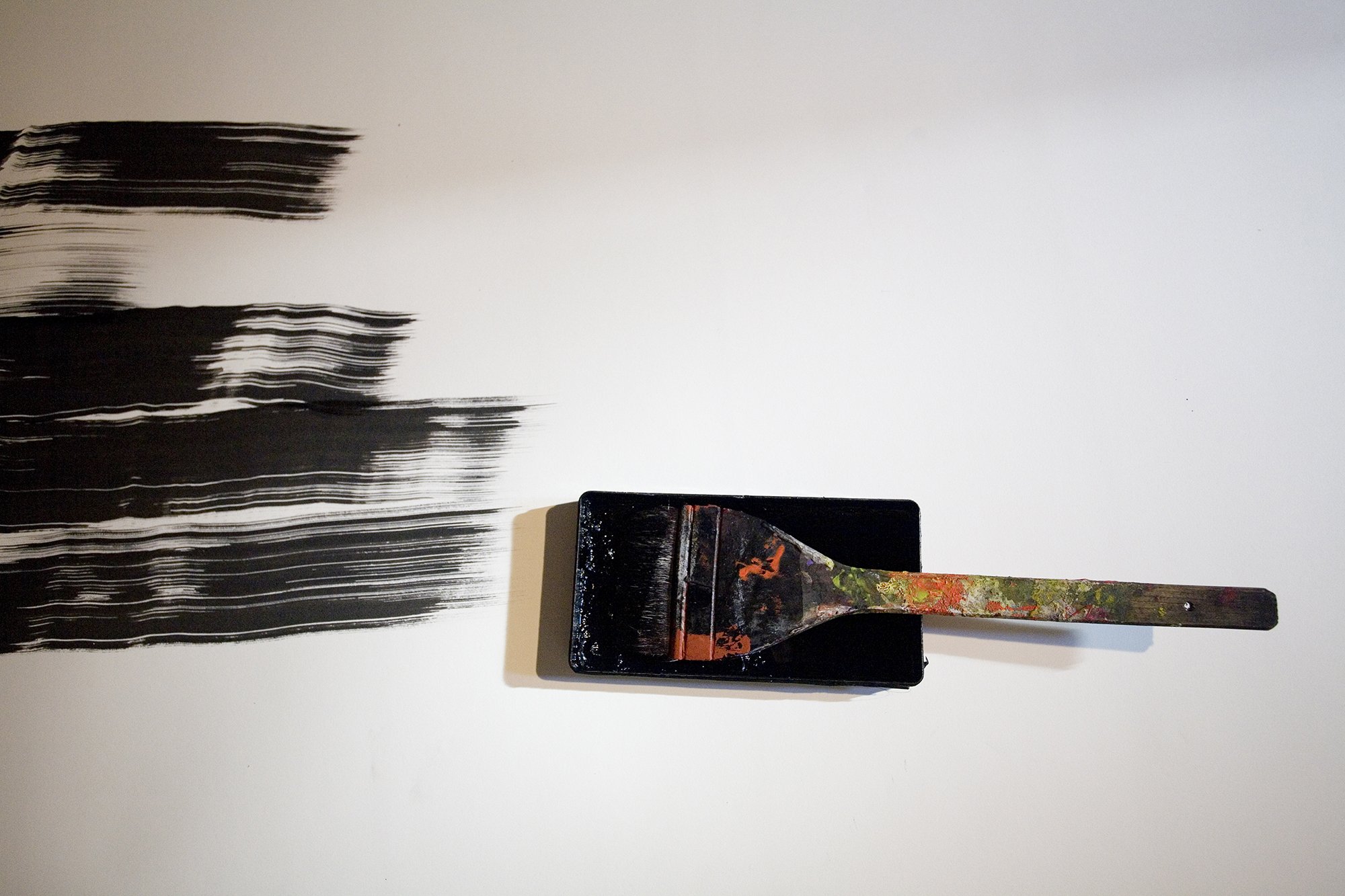


















As luck would have it, I showed up on the first day they began working at the re-converted match stick factory named Central Park, in Barracas, Buenos Aires. It was the day they draped the canvas onto its huge frame. My Spanish wasn’t so great, so throughout those three months, I made prints and distributed them to his team, to show what I was doing. This was before instagram and smart phones.
Yuyo in action one night, on a fresh roll of paper.
Some of Yuyo’s brushes.
It’s hard to select photos to share from my time documenting his work and process. There are so many.
In remembering Yuyo and his work, the warm family of friends that surrounded him and welcomed me, I have deep gratitude. It brought vibrant colors to my dreams and opened up doors of perception.
In my work, I put everything into a frame, with a certain obsession for geometry, which Cartier-Bresson said was necessary for a photographer. Being with Yuyo’s paintings, observing him creating, loosened my tight fist on geometry and relaxed my thirst for a certain order, learning to appreciate a different kind of order in chaos.
Yuyo adding details with a white pen.
Yuyo, wherever you are now, I wish you peace and joy, seeing how your work and care and vision expands through each person that you touched during your time here. Give a hug to your dear Nora. Thank you for opening your home, your studio, and your heart. I’ll pay it forward in your honour.
Merci, Yuyo. Bon voyage dans l’au-delà.
J’ai appris cette semaine que Yuyo Noé a quitté son corps. Comme pour chaque départ, un tourbillon d’émotions s’est levé. J’éprouve une grande tristesse, car c’était un artiste et un être humain d’une générosité rare, partageant tant de son temps, de sa vision et de sa créativité.
J’ai eu la grande chance de pouvoir photographier son processus lorsqu’il a créé son œuvre monumentale pour la Biennale de Venise en 2009.
Il avait alors 75 ans, et travaillait tard dans la nuit, écoutant Bach, un gin tonic à côté. J’aurais pu le regarder peindre pendant des heures, mais à un moment donné je rentrais chez moi, et le lendemain matin en revenant à l’atelier, j’étais toujours émerveillée par tout ce qu’il avait encore créé après mon départ.
Pendant ces journées passées en Argentine, avec Yuyo et de nombreux autres artistes talentueux, j’ai compris qu’en consacrant son quotidien à créer — à faire ce qui vous anime — avec le cœur et l’âme, on reste “jeune”, ou plutôt vivant et habité d’un sens profond. On en parle beaucoup aujourd’hui, mais on oublie vite. Le temps passé auprès de ces artistes m’a permis de le voir, le sentir, l’intégrer.
Et dans les années qui ont suivi cette biennale, j’ai revu Yuyo plusieurs fois à Paris, et j’ai toujours senti que sa créativité était un moteur puissant.
Être témoin de son éthique de travail était inspirant — un exemple de dévouement. Être plongée dans cette “soupe” créative m’a permis de m’autoriser à faire pareil. Sa famille était si différente de la mienne. Sa fille est aussi artiste, et j’ai toujours perçu dans sa pratique une étincelle vitale, une force intemporelle. Là où sa famille considérait son “job alimentaire” comme une perte de temps et sa pratique artistique comme le vrai travail, dans ma famille américaine du Midwest, c’était exactement l’inverse. Le défi, je crois, est de trouver son propre équilibre sur le chemin.
Observer le processus créatif de Yuyo a ouvert de nombreuses portes dans mon esprit. Lorsqu’il déchirait des morceaux de peinture de la veille pour les intégrer à la grande toile, je retenais presque mon souffle. En le regardant faire, je ressentais une joie enfantine — “allez, on essaie ! c’est marrant !” — mais je voyais aussi une maîtrise et une vision très claires derrière l’acte.
Le hasard a bien fait les choses : je suis arrivée le tout premier jour du travail à la fabrique d’allumettes reconvertie, appelée Central Park, à Barracas (Buenos Aires). C’était le jour où ils ont tendu la toile sur son énorme châssis. Mon espagnol n’était pas terrible à l’époque, alors pendant ces trois mois, j’ai tiré des épreuves que je distribuais à son équipe, pour montrer ce que je faisais. C’était avant Instagram et les smartphones…
C’est difficile de choisir quelles photos partager de ce moment passé à documenter son œuvre et son processus. Il y en a tant.
En me souvenant de Yuyo, de son travail, et de la chaleureuse famille d’amis qui l’entourait et m’a accueillie, je ressens une profonde gratitude. Cette période a mis des couleurs vives dans mes rêves et ouvert de nouvelles portes de perception.
Dans mon travail, j’ai toujours tout cadré avec une certaine obsession pour la géométrie — obsession que Cartier-Bresson disait nécessaire pour un·e photographe. Être auprès des toiles de Yuyo, le voir créer, a relâché cette crispation, détendu mon besoin de rigueur, et m’a appris à reconnaître un autre type d’ordre dans le chaos.
Yuyo, où que tu sois maintenant, je te souhaite la paix et la joie, en voyant combien ton œuvre, ta bienveillance et ta vision continuent à se diffuser à travers chaque personne que tu as touchée durant ton passage ici. Embrasse ta chère Nora. Merci d’avoir ouvert ta maison, ton atelier et ton cœur. Je continuerai à transmettre, en ton honneur.
Prussian Blue
I’ve had a love affair with the cyanotype process for over a decade, and I teach the process every summer during my summer class with Oxbridge. Recently I did a workshop at the Chouette au Loing, a new multi-use space that has opened up in Moret-sur-Loing. I love seeing people discover this process for the first time, their eyes bright with the spark of creativity and possibility. Everyone feels so fulfilled at the end, having made something beautiful from scratch, with their own hands. Here’s to #humanmade!
Version français ci-dessous
I’ve had a love affair with the cyanotype process for over a decade, and I teach the process every summer during my summer class with Oxbridge. Recently I did a workshop at the Chouette au Loing, a new multi-use space that has opened up in Moret-sur-Loing.
I love seeing people discover this process for the first time, their eyes bright with the spark of creativity and possibility. Everyone feels so fulfilled at the end, having made something beautiful from scratch, with their own hands. Here’s to #humanmade!
We used plants and negatives, brushes and sponge brushes, and a UV light, because at this time of year the sun still can’t be counted on. I love seeing everyone experiment, and how some people adore seeing the brush strokes, and others prefer clean, minimalist borders.
We made a bit of a creative mess, as you do. #myhappyplace
Bleu de Prusse
Cela fait plus de dix ans que j’entretiens une histoire d’amour avec le cyanotype, et chaque été, j’enseigne ce procédé pendant mon cours d’été avec Oxbridge. Récemment, j’ai animé un atelier à La Chouette au Loing, un nouvel espace polyvalent qui a ouvert à Moret-sur-Loing.
J’adore voir les gens découvrir cette technique pour la première fois, les yeux brillants d’une étincelle de créativité et de possibilités. À la fin, chacun repart comblé d’avoir créé quelque chose de beau, de ses propres mains, à partir de rien. Vive le fait main humain ! #humanmade
Nous avons utilisé des plantes, des négatifs, des pinceaux et des brosses en mousse, ainsi qu’une lampe UV, car à cette époque de l’année, on ne peut pas encore vraiment compter sur le soleil. J’aime observer les expérimentations de chacun : certain·es adorent voir les traces de pinceau, d’autres préfèrent des bordures nettes et minimalistes.
On a mis un peu le bazar créatif — comme il se doit. #myhappyplace
The Scream
Revisiting some older self portraits and telling the story from my future self’s perspective. A sort of inventory on the occasion of having spent 20 years in France.
At the time, I judged this photo as not good enough. I didn’t like what I was wearing, I didn’t like the light, or my hair. I’d made it too fast, without thinking about all the details. I tried to re-make it later, but the mask was lost and I never found a replacement. So I accept it as it is. A stepping-stone on the path of self-understanding.
Version français ci-dessous
Revisiting some older self portraits and telling the story from my future self’s perspective. A sort of inventory on the occasion of having spent 20 years in France.
That white plaster mask was everything I was looking for that day, years ago. The discomfort of searching in the pregnant space between idea/feeling, and creating the thing/the art. I hadn’t had any therapy yet, and more parts of myself were hidden from my consciousness than they are today. Playing in front of the camera was the first place they started to come through.
I couldn’t look myself/the camera lens in the eye. Today, looking at this photo, that’s what I see first. I remember trying to look at the camera, and then looking away. Some part of me wanted to scream but the rest of me wouldn’t allow it, so I used a mask.
I could feel my discomfort reflected back at me when I looked directly at the camera. But what was it? And at who? At me? My family? The world? The neighbours? And why was I confronting myself with the camera, that recorded more than I knew I was expressing?
I was trying to express something I didn’t have words for, and was apprehensive about seeing. With a small amount of courage, in my studio as a resident at 59 Rivoli in Paris, I was playing artist and feeling full-on imposter. Summoning inspiration. Using found objects to “test my light.” I couldn’t even say I was making self portraits until it became obvious. I’d say I was just testing the light on myself, before a portrait shoot.
I noticed the theme of voice/ sound/ silence/ auto-censorship was recurring. I continued to show up. There was something inside me pushing back at the creativity that urged to push forward. It was a vicious judge, and I didn’t yet know that I could tell that inner critic, who wanted to keep me safe and static, to get in the friggin back seat. It’s like I was flooring it, trying to get onto the highway in second gear. I can still feel what that was like (and sometimes still is!), that made me want to scream exactly like that plaster face.
At the time, I judged this photo as not good enough. I didn’t like what I was wearing, I didn’t like the light, or my hair. I’d made it too fast, without thinking about all the details. I tried to re-make it later, but the mask was lost and I never found a replacement. So I accept it as it is. A stepping-stone on the path of self-understanding.
Le Cri
Je revisite d’anciens autoportraits et raconte l’histoire depuis la perspective de mon moi du futur. Une sorte d’inventaire, à l’occasion de mes 20 ans passés en France.
Ce masque en plâtre blanc, c’était exactement ce que je cherchais ce jour-là, il y a des années. L’inconfort de la recherche, dans cet espace suspendu entre l’idée ou le ressenti, et la création de l’œuvre. Je n’avais pas encore entamé de thérapie, et plus de parties de moi étaient encore cachées dans l’ombre que ce n’est le cas aujourd’hui. Jouer devant l’appareil photo a été le premier endroit où ces parts de moi ont commencé à émerger.
Je ne pouvais pas me regarder dans les yeux, ni dans le miroir de l’objectif. Aujourd’hui, en revoyant cette photo, c’est la première chose que je remarque. Je me souviens d’avoir essayé de regarder l’appareil, puis d’avoir détourné le regard. Une partie de moi voulait hurler, mais le reste ne le permettait pas. Alors j’ai utilisé un masque.
Je voyais mon malaise reflété quand je regardais l’objectif en face. Mais qu’est-ce que c’était ? Et dirigé vers qui ? Moi ? Ma famille ? Le monde ? Les voisins ? Et pourquoi cette confrontation avec moi-même à travers l’objectif, qui captait plus que ce que je savais exprimer ?
J’essayais de dire quelque chose pour lequel je n’avais pas de mots, et que j’appréhendais de voir. Avec un peu de courage, dans mon atelier à 59 Rivoli à Paris, je jouais à l’artiste, tout en me sentant imposteur·e à fond. J’invoquais l’inspiration. J’utilisais des objets trouvés pour « tester ma lumière ». Je n’osais même pas dire que je faisais des autoportraits, jusqu’à ce que ça devienne évident. Je disais juste que je testais la lumière sur moi, avant un shooting.
Je voyais revenir un thème : voix / son / silence / auto-censure. J’ai continué à revenir, encore et encore. Quelque chose en moi résistait à la créativité qui poussait vers l’avant. C’était un juge féroce, et je ne savais pas encore que je pouvais dire à cette voix intérieure — celle qui voulait me garder en sécurité et immobile — d’aller se mettre à l’arrière, et de ne plus toucher au volant. C’était comme essayer de prendre l’autoroute en seconde. Je ressens encore ce que c’était (et parfois c’est encore le cas !), cette pression qui me donnait envie de hurler, exactement comme ce masque figé.
À l’époque, je trouvais cette photo ratée. Je n’aimais pas ce que je portais, je n’aimais pas la lumière, ni mes cheveux. Je l’avais faite trop vite, sans penser à tous les détails. J’ai essayé de la refaire plus tard, mais le masque était perdu, et je n’en ai jamais retrouvé un pareil. Alors je l’accepte telle qu’elle est. Une pierre sur le chemin de la compréhension de soi.
It flipped the switch
My story-teller switch is ON. There’s something of a relief, like an open flowing of the natural energy of my role in the world. My goal becomes capturing the soul of that gathering of humans, the feeling of their relationships, the humorous interactions and reactions, the fun, the light, the fabric of it. It’s one of my main raisons d’être.
Version français ci-dessous
We were at a friend’s daughter’s 5th birthday party last month. It was a beautiful hot day, in a beautiful setting. I hadn’t brought my camera but thought I’d take a few photos with my iPhone, like everyone else. It was a relaxing afternoon and then just before the cake was going to come out, the birthday girl’s mom asked if I could take some photos.
That’s the click.
It flipped the switch, turned on the photographer in me. Not to compare myself to a dog, but when this happens, it reminds me of a service dog who is happy to be doing his job. And it’s almost like I see through different eyes afterwards. My story-teller switch is ON.
There’s something of a relief, like an open flowing of the natural energy of my role in the world. My goal becomes capturing the soul of that gathering of humans, the feeling of their relationships, the humorous interactions and reactions, the fun, the light, the fabric of it. It’s one of my main raisons d’être.
Le déclic
Le mois dernier, on était à l’anniversaire des 5 ans de la fille d’une amie. Une journée magnifique, chaude, dans un cadre superbe.
Je n’avais pas pris mon appareil photo, mais comme tout le monde, je me suis dit que j’allais faire quelques photos avec mon iPhone. L’après-midi était tranquille, détendue.
Et puis, juste avant que le gâteau n’arrive, la maman de la petite me demande si je peux prendre quelques photos.
Et là — clic.
Le déclic. L’interrupteur se retourne, et la photographe en moi s’allume.
Je ne vais pas me comparer à un chien, mais franchement, quand ça m’arrive, ça me fait penser à un chien d’assistance, tout content de faire ce pour quoi il est né. Et c’est presque comme si je voyais avec d’autres yeux, après. Le mode “conteuse” est activé.
C’est un soulagement, même. Comme une énergie naturelle qui peut enfin circuler, comme si je retrouvais ma place dans le monde.
Mon objectif devient alors de capter l’âme de ce rassemblement d’humains, de saisir leurs liens, leurs échanges drôles ou tendres, leur joie, la lumière, la trame du moment.
C’est l’une de mes raisons d’être.
Two weeks of Dirty Laundry @ 59 Rivoli
Tout s’est aligné comme si c’était écrit dans les étoiles.
L’idée s’est glissée dans mon esprit : pourquoi ne pas proposer une expo au 59 Rivoli ? (Un lieu avec lequel j’ai une longue histoire.)
Ma première réponse : oh, je n’ai pas le temps…
Mais silencieusement, dans un coin de ma tête : Et si je prenais le temps, je ferais quoi ? Et là, je l’ai vu tout de suite.
Version français ci-dessous
Photo by Alex Katar
It all came together as if written in the stars.
The idea was planted in my brain: why not propose an exhibition at 59 Rivoli ? (A place I have a long history with).
My response: Oh, I don’t have time…
But quietly in my mind: If I could make the time, what would I do?
I saw it right away. I’d build an exhibition with Zoe Duchesne and Vilma Pimenoff, feeling how our work would interact and communicate in this space. I contacted Vilma, who lives in Helsinki, and asked her if there was any chance she’d like to come to Paris and exhibit. The timing was perfect, she was coming for a two month residency at Cité des Arts. Awesome.
Then I contacted Zoe, not knowing that only a couple weeks prior, she’d written in her journal that she wanted to do more collective projects. Again, perfect timing.
It had been 7 years since I had shown anything from this body of work.
I was 4 months pregnant last time.
I quickly put together a proposal, and when the question about a title arose, the answer was already there. Dirty Laundry. I had this phrase in my collection of bits of writing, formed using cut-ups from magazines, “you are writing things like pieces of dirty laundry.” When the words had appeared in this sequence, it immediately felt like a warning or judgement from the realm of “shoulds.” Maybe I shouldn’t be writing these things. Maybe I shouldn’t be sharing these thoughts. Maybe I shouldn’t be expressing my feelings like this. Maybe I should keep this private. Maybe I’m wrong. Maybe my photos bother people. Or maybe I should put the doubts in the backseat and keep moving forward and see what happens!
Positioning our giant exhibition poster, designed by Matthieu Delahaie, in the window of 59 Rivoli. Vilma Pimenoff is outside guiding us to make sure it’s straight.
The impulse to create doesn’t go away. We’re inherently creative beings. Are there certain things we should not share? I have this idea that if I stay low, and don’t get knocked out by the auto-censor, and just make the damn work, there could be freedom and joy on the other side. (Ah, but do I have the right? my inner keep-it-safe-and-quiet critic says.) This is knocking up against a false belief that I need permission! It feels like I need a signed permission slip between me and joy!
Red thread corset
Anyway, let’s keep going. On the other side of the creative void, there could be connection with people who feel the same and understand, and maybe want to talk about it. That possibility is exciting enough to keep going.
This idea of airing your dirty laundry has brought up very diverse responses, making it clear that everyone has different degrees of comfort in how much personal stuff they share outside of their circle of close loved ones.
Here’s a short video of us talking about how we see Dirty Laundry, and a display of French spoken by a Quebecoise, Américaine and a Finlandaise!
Deux semaines de Dirty Laundry @ 59 Rivoli, Paris
Tout s’est aligné comme si c’était écrit dans les étoiles. L’idée s’est glissée dans mon esprit : pourquoi ne pas proposer une expo au 59 Rivoli ? (Un lieu avec lequel j’ai une longue histoire.)
Ma première réponse : oh, je n’ai pas le temps…
Mais silencieusement, dans un coin de ma tête : Et si je prenais le temps, je ferais quoi ?
Et là, je l’ai vu tout de suite. Je construirais une expo avec Zoé Duchesne et Vilma Pimenoff, sentant à quel point nos travaux pourraient dialoguer ensemble dans cet espace.
J’ai contacté Vilma, qui vit à Helsinki, pour lui demander si par hasard elle aurait envie de venir exposer à Paris. Le timing était parfait, elle arrivait pour une résidence de deux mois à la Cité des Arts. Génial.
Puis j’ai écrit à Zoé, sans savoir que quelques semaines plus tôt, elle avait noté dans son journal qu’elle voulait faire plus de projets collectifs. Encore une fois, timing parfait.
Cela faisait sept ans que je n’avais rien montré de cette série.
La dernière fois, j’étais enceinte de quatre mois.
J’ai rapidement monté un dossier, et quand la question du titre s’est posée, la réponse était déjà là. Dirty Laundry. J’avais cette phrase dans ma collection de textes découpés dans des magazines : “you are writing things like pieces of dirty laundry.” Quand ces mots sont apparus dans cet ordre, j’ai ressenti comme un avertissement, un jugement venu du royaume des “tu devrais”. Peut-être que je ne devrais pas écrire ça. Peut-être que je ne devrais pas partager ces pensées. Peut-être que je ne devrais pas exprimer mes émotions de cette façon. Peut-être que je devrais garder ça pour moi. Peut-être que j’ai tort. Peut-être que mes photos dérangent.
Ou peut-être que je devrais foutre tous ces doutes à l’arrière et avancer pour voir ce qui se passe.
L’impulsion de créer ne disparaît pas. On est des êtres créatifs, par nature. Est-ce qu’il y a des choses qu’on ne devrait pas partager ?
J’ai cette idée que si je reste basse, si je ne me fais pas assommer par l’auto-censeur, et que je fais juste le boulot, il pourrait y avoir de la liberté et de la joie de l’autre côté. (“Ah, mais est-ce que j’ai le droit ?” murmure ma petite voix prudente.)
Ça vient heurter cette croyance absurde que j’ai besoin d’une autorisation ! Comme s’il me fallait un mot signé entre moi et la joie !
Bref, continuons.
De l’autre côté du vide créatif, il y a peut-être des connexions à faire, avec d’autres personnes qui ressentent la même chose, qui comprennent, et qui peut-être veulent en parler. Et cette possibilité-là me donne envie d’avancer.
Cette idée d’“étaler son linge sale” a suscité des réactions très diverses, révélant à quel point chacun a un seuil différent en matière d’intimité, et de ce qu’il est prêt à partager en dehors de son cercle proche.

